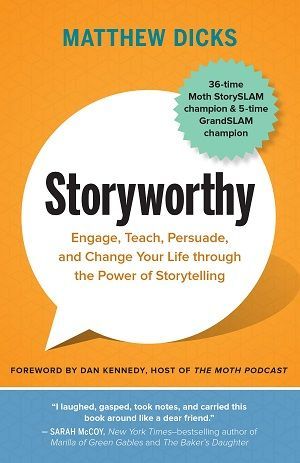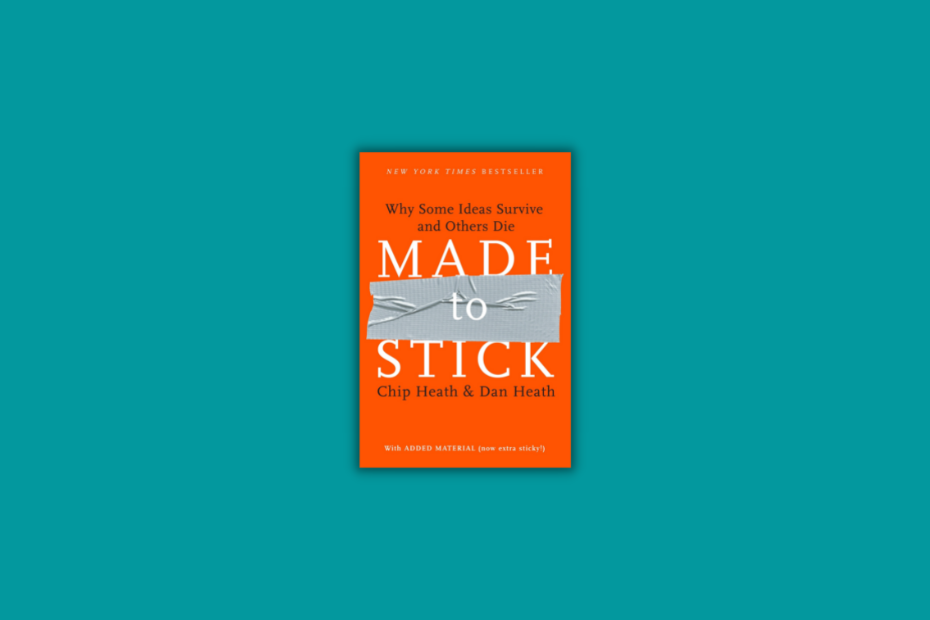Storyworthy by Matthew Dicks: Book Summary & Notes
Exercises of storytelling workshops, concrete and immediately applicable tips, story examples, and a summary of Storyworthy.

When you hear the word storytelling, the first thing that comes to mind is TED talks optimized to elicit emotions. Soon afterward, the call words of countless "storytelling workshops" and the worn-out mottos of trainers ring in my ears.
Storytelling can be approached from many directions, with countless preconceptions. There is also a pejorative overtone to professional storytelling.
This is how you tell your story,
- to make an impact,
- to make your business presentation a success,
- to manipulate others.
But a good story is much more than manipulation. In fact, a good story requires honesty and vulnerability.
I'm not a good storyteller. If I have a story, I can conjure up memorable moments for my audience, but my problem is rooted elsewhere.
I don't have good stories.
And that has always been the case. When I came home from school, I would usually list the elements of the lunch in response to the question of what happened at school. Needless to say, nowadays I give similarly detailed answers to what was your day like.
In addition, the telling of my few good stories mostly lives only in my memory as an exceptional storytelling achievement.
That's why I picked up Matthew Dicks' book on storytelling.
I wanted to make a difference. And Storyworthy delivered much more than I expected. It turned out that my life was not boring, but that I was simply missing the storyworthy moments.
The storytelling veteran, short story writer, teacher-author has woven together decades of experience as a competitive storyteller (because there is such a thing) and the practices of his own storytelling workshops into a practical book of concrete and immediately usable tips, storytelling examples, and unabashedly good practices.
This is my summary of Matthew Dicks' Storyworthy.

Matthew Dicks: Storyworthy
Engage, Teach, Persuade, and Change Your Life through the Power of Storytelling
Storytelling as a Superpower
"No one ever made a decision because of a number. They need a story." - Daniel Kahneman
According to Matthew Dicks, anyone who can speak to others in an entertaining and engaging way has a superpower that is in short supply in the world.
Reading the first few chapters of the storytelling book, I thought this was an exaggeration, but by the end of the book, the author has fully proved his point.
Practices for finding your stories
The Dinner Test
If you're not sure whether the story you're preparing for a stage, a conference, or a Sunday service is the right one, put it to the test with the Dinner Test.
Ask yourself the question:
Would you tell your story to a friend over dinner?
A good story, for sure.
Homework for life
We don't have stories not because nothing is happening in our lives, but because we don't notice the right moments.
We don't notice the moments and we don't notice their significance.
And when something extraordinary happens, we don't touch it and record it, so we don't save these precious moments for the future.
The author asks himself one simple question every night:
"If I had to tell a story from today — a five-minute story onstage about something that took place over the course of this day — what would it be?"
A complete story for each day would be too demanding, and instead Matthew Dicks suggests just a short description of the moment. One or two sentences describing the story in sufficient detail to be able to recall it at a later moment.
Dicks collects these story seedlings in an Excel spreadsheet. He turns to this source when he is writing his highly influential stage stories.
Crash & Burn
Crash & Burn is a conscious writing technique that the author says is like dreaming with the tip of your pen. When you really work at Crash & Burn, the practice reveals connections of thought that we usually only discover in our dreams.
The point of the exercise is to jot down whatever thoughts come to mind, no matter how strange, vulgar, or disturbing they may be.
However, it is worth following a few rules to get the most out of the exercise:
1. Don't stick to any idea!
Don't stick to any idea.
Don't get attached to themes, events, or emotions.
Simply write down what comes to mind!
2. Don't judge your thoughts!
Write down everything that comes to mind, no matter how strange, sick, or shameful it may sound. Grammar and grammar correctness are not important in this exercise.
When you've finished the exercise, read back the results and look for ideas, story bases, memories that you can turn into anecdotes and stories later.
First - Last - Best - Worst
All you need for this game is a piece of paper and a pencil.
Make a table with six columns!
Create a Prompts column next to the First - Last - Best - Worst columns.
Prompts are the keywords, the questions to bring up memories.
For example, if the prompt is the word dog, the cells in the first row should be filled with your answers to the following questions:
- What was the name of your first dog?
- What was the name of your last dog?
- What was the name of your best dog?
- What was the name of your worst dog?
To complete the exercise, you may want to look for snippets of stories with the following guided questions
- Do any of these entries occur more than once? (potential story)
- Would I be able to turn any of the entries into a useful anecdote?
- Would I be able to turn any of the entries into a complete story?
Rules of Storytelling
1. The simpler your story, the better!
The author was resuscitated after a car accident, arrested on false charges, and had a gun to his head during a robbery, yet most of the stories he tells in the book are not related to these events.
In fact, it is the simple stories and the small moments in our lives that matter. And everyone benefits from these stories, we just need to notice the storyworthy moments.
A night in jail, while interesting, is something many people can't relate to. But we can identify with the everyday stories and feelings.
2. Make your story evolve!
A good story should reflect changes over time, while not remaining just a series of remarkable events. You need to go from a version of yourself to a better (or worse) version of yourself.
Most people link paragraphs and sentences in their stories with the word AND. This is a mistake. The ideal connectors for a story are BUT and THEREFORE, and their infinite synonyms.
AND stories have neither direction nor unique moments. BUT and THEREFORE, on the other hand, are used to denote change.
3. Tell YOUR story!
You should tell your own story, not other people's! People would rather listen to a story about your Saturday night than Pete's Saturday night, even if Pete's story is much better than yours.
Don't tell other people's stories!
Tell your own!
However, it's okay to tell other people's stories if you are one of the main characters in the story.
4. Find your five-second moment!
Every great story you've ever told is practically a five-second moment, a brief realization that you've had a split-second moment of realization, a moment of change, or both.
The aim of your story is to convey that five-second moment as clearly as possible.
Don't focus on the big moments, the incredible circumstances, or the funny details! Find your five-second moment, because that's what moves hearts!
5. Start your story near the end!
Like Kurt Vonnegut's stories, try to start your story as close to the end as possible. Leave out locations, characters, events if they don't add to the ending!
Strive for simplicity!
6. Less scene, more movement
Using fewer locations simplifies a lot of things and makes your story more consumable for the audience.
However, always try to connect these locations with movement. At the beginning of your story, present yourself as a person in motion. Starting with movement gives the story momentum.
7. Don't set expectations!
How do most people start their stories?
They set expectations:
- "You won't believe this..."
- "You need to hear this..."
- "This is the best story I've ever heard..."
They make it hard for themselves. They set a high bar that most of the time they can't clear.
Don't set expectations!
Start with the story!

8. Don't mention the weather!
When the weather is nice, everyone knows.
If it's not, everyone knows that too.
Reminding your audience of obvious facts is not only unnecessary, but it's also boring.
9. Quotes
- Don't use a quote you have already heard in another speech.
- Don't use any quotes if you can!
- Instead, be quotable! Your job is not to recycle other people's thoughts, but to create something new!
10. Put an Elephant in the room!
If you don't give a clear reason why your audience should pay attention to you, you can easily lose their attention. The elephant shows the audience what they can expect. It gives them a reason to pay attention.
11. The Backpack
The backpack is a strategy that raises the stakes of the story by increasing the audience's anticipation of what is about to happen.
We talk about backpacking when a storyteller shares his or her hopes and fears with the audience before the event occurs, before moving on with the events.
Backpacks work best when a plan doesn't work.
If I told you how I planned to get down on my knees begging for free gas (story in the book) but got gas without a problem, the backpack would make no sense.

12. Breadcrumbs
Storytellers use breadcrumbs when they hint at an event in the future, but just enough to keep the audience guessing.
In the story "The Beneficial Thief", Matthew Dicks runs out of gas on his way home. The gas station refuses to give him free gas. He sits in his car next to his blue McDonald's uniform lying on the passenger seat, mourning his life.
Later, he knocks on the door of the neighborhood in his uniform as a fundraiser for the Mcdonald's Foundation.
But the uniform in the car is just a breadcrumb.
It heightens the anticipation, but reveals almost nothing.
13. Storytelling and Lies
The essence of storytelling is to tell true stories that have happened, but no story is completely true. Intentionally or not, our stories contain inaccuracies, mistakes, and slipped memories.
In our stories, we can only lie when our audience wants us to lie or when the story is made better by our fibs.
We never add anything to the story that wasn't there originally, but we can leave out details if it makes the story better.
Letting go of unnecessary details
The author tells the story of a Saturday afternoon when he and his sister planned and then jumped off the roof of their house on a bicycle. In reality, they spent a whole day planning and then carried out the operation the next day, but this is an irrelevant detail for the story.
Dicks tells the story as if it had all happened in a single day because it is much more dynamic and enjoyable that way.
14. Laughter and Humor
Humour allows you to connect with your audience from the first moment, and laughter will get them through the less exciting parts of the story.
It's worth making your audience laugh right at the start of the story, as an early laugh can achieve three things:
- It signals to the audience, "I'm a good storyteller. I know what I'm doing. Relax, you can sit back."
- With a smaller audience, in a less formal setting, an early laugh precedes a shout-in. It's an unspoken signal that you're in charge.
- No matter how emotionally intense and taxing the story, you signal right at the start, "I'm fine and I even made you laugh."
Humor alone is not a magic bullet.
It doesn't make your story interesting, it doesn't give you a reason to pay attention, and it doesn't add mystery to your story. However, it does have its advantages if you use laughter well.
When a part of a story becomes particularly tense and the audience needs a reset, laughter is the best tool you can use.
15. Use the Present tense
Present tense in storytelling is like a magnet: it can suck anyone into the story at any time.
If you are talking about the past, you should also use the present tense. That way your audience can be there with you live in every scene of the story.
16. Forget the mirror!
The one place in the world where you should not practice public speaking is in front of a mirror. When you stand in front of a mirror, you see something when you speak that you will never see in person: yourself.
17. We love Underdog stories
Love for underdog stories is universal.
Underdogs are supposed to lose, so when they win unexpectedly, the joy is cathartic. It is even greater than the deep sorrow when they lose.
But the victory of the underdog is far more exciting.
Victory is unexpected, while defeat is inevitable in such a story.
18. Storytelling dont's
- Don't ask rhetorical questions! Rhetorical questions force listeners to think and take them out of the timeline of your story.
- Don't address the audience, don't acknowledge their existence!
- Don't mention the words story or story words in your story! (That's another story...etc.) With these terms, you remind your audience that they are listening to a story.
- Do not imitate other people's accents or dialects! Most of the time it is rude and at worst racist.
- Don't memorize your story! It is difficult to be vulnerable and believable when reciting memorized lines. However, it pays to learn the three parts of your story exactly:
- The first few sentences: always start strong
- The last few sentences: always finish strong
- The scenes of your story
19. Eye contact
Find one person on the left edge of the audience, one on the right edge, and one exactly in the middle.
Look for people at these points who are smiling, nodding, laughing. Use these people as beacons. Make eye contact with these three people alternately and the people around them (i.e. the whole audience) will feel that you are connected to them.
20. Evoke emotions at the end of your story
Too often stories end with a joke, a situation with a ridiculous ending, or worse: a pun.
We like a laugh.
We want to laugh.
But we listen to stories because we expect them to have an impact.

Matthew Dicks: Storyworthy
Engage, Teach, Persuade, and Change Your Life through the Power of Storytelling




